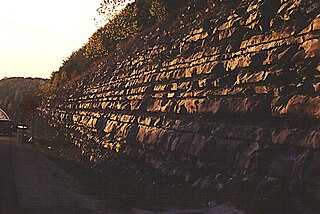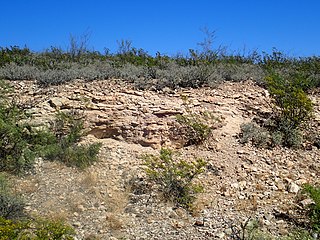Edwardsville is an unincorporated community in Georgetown Township, Floyd County, Indiana. The Duncan Tunnel is located at Edwardsville.

The Rundle Group is a stratigraphical unit of Mississippian age in the Western Canadian Sedimentary Basin.

The New Albany Shale is an organic-rich geologic formation of Devonian and Mississippian age in the Illinois Basin of the United States. It is a major source of hydrocarbons.

The Mississippian Borden Formation is a mapped bedrock unit in Kentucky, Indiana, Illinois, Ohio, West Virginia, and Tennessee. It has many members, which has led some geologists to consider it a group rather than a formation.

The Logan Formation is the name given to a Lower Carboniferous siltstone, sandstone and conglomeratic unit exposed in east-central Ohio and parts of western West Virginia, USA.

The Fayetteville Shale is a geologic formation of Mississippian age composed of tight shale within the Arkoma Basin of Arkansas and Oklahoma. It is named for the city of Fayetteville, Arkansas, and requires hydraulic fracturing to release the natural gas contained within.

Paleontology in Indiana refers to paleontological research occurring within or conducted by people from the U.S. state of Indiana. Indiana's fossil record stretches back to the Precambrian, when the state was inhabited by microbes. More complex organisms came to inhabit the state during the early Paleozoic era. At that time the state was covered by a warm shallow sea that would come to be inhabited by creatures like brachiopods, bryozoans, cephalopods, crinoids, and trilobites. During the Silurian period the state was home to significant reef systems. Indiana became a more terrestrial environment during the Carboniferous, as an expansive river system formed richly vegetated deltas where amphibians lived. There is a gap in the local rock record from the Permian through the Mesozoic. Likewise, little is known about the early to middle Cenozoic era. During the Ice Age however, the state was subject to glacial activity, and home to creatures like short-faced bears, camels, mammoths, and mastodons. After humans came to inhabit the state, Native Americans interpreted the fossil proboscidean remains preserved near Devil's Lake as the bones of water monsters. After the advent of formal scientific investigation one paleontological survey determined that the state was home to nearly 150 different kinds of prehistoric plants.

Agaricocrinus americanus, also known as the mushroom crinoid or American crinoid, is a species of extinct crinoid. Its fossils can be found in the U.S. states of Indiana, Tennessee and Kentucky. They date back to the Lower Mississippian, about 345 million years ago.

The Redwall Limestone is an erosion-resistant, Mississippian age, cliff-forming geological formation that forms prominent, red-stained cliffs in the Grand Canyon. these cliffs range in height from 150 m (490 ft) to 244 m (801 ft). It is one of the most fossiliferous formations exposed in the Grand Canyon region.

The Hale Formation is a geologic formation in northern Arkansas that dates to the Morrowan Series of the early Pennsylvanian. The Hale Formation has two named members: the Cane Hill and the Prairie Grove Members. The lower member is the Cane Hill, a primarily sandstone and shale interval that unconformably overlies the Mississippian-age Pitkin Formation. The upper member, the Prairie Grove Member, is predominately limestone and conformably underlies the Bloyd Formation.
The Hindsville Formation, or Hindsville Limestone Member of the Batesville Formation, is a geologic unit in northern Arkansas and eastern Oklahoma that dates to the Chesterian Series of the late Mississippian. Named for the town of Hindsville in Madison County, Arkansas, this unit is recognized as a member of the Batesville Formation in Arkansas and a geologic formation in Oklahoma. Although, some workers have proposed raising the rank of this interval in Arkansas to formation status. Both the Batesville and Hindsville Formations overlie the Moorefield Formation and underlie the Fayetteville Shale.

The Bloyd Formation, or Bloyd Shale, is a geologic formation in Arkansas. It preserves fossils dating back to the Carboniferous period.

The Burlington Limestone is a geologic formation in Missouri, Iowa and the Midwest region. It preserves fossils dating back to the Mississippian subperiod.

The Leadville Limestone is a Mississippian geologic formation in the western United States. In Colorado, the upper part is oolitic limestone, while the lower part is primarily dolomite, and somewhat sandy beds indicate the bottom of the formation.

The Lake Valley Limestone is a geologic formation widely exposed in southwestern New Mexico. It preserves fossils dating back to the lower to middle Mississippian.

The Madera Group is a group of geologic formations in northern New Mexico. Its fossil assemblage dates the formation to the middle to late Pennsylvanian period.
The Percha Formation is a geologic formation in southern New Mexico. It preserves fossils dating back to the Famennian Age of the late Devonian period.

Onychocrinus is an extinct genus of crinoids.
The Rancheria Formation is a geologic formation in the Sacramento and San Andres Mountains of New Mexico, the Franklin Mountains of southern New Mexico and western Texas, and the Hueco Mountains of western Texas. It preserves fossils dating back to the Visean Age of the Mississippian.














